Chess has been one of my biggest learning goals during this Summer Vacation. So, I have been studying it every morning, and now I think I have improved in it by a large mark. Now, in this page, I am going to explain the various strategies, checks, and mates that I’ve learned in the past weeks.
◊ – ◊ – ◊ – ◊ – ◊ – ◊ – ◊ – ◊ – ◊ – ◊ – ◊ – ◊ – ◊ – ◊ – ◊ – ◊ – ◊ – ◊ – ◊ – ◊ – ◊ – ◊ – ◊
Opening the Game
Opening a game of chess in the right manner is crucial to start attacking and soon, mating. The best way to open the game is to develop pieces (i.e, the Rook, Knight, and Bishop.) into the game. So, since the knight is the only piece that can jump over other pieces, a powerful move would be NF3, or NH3. This opening move is called the Reti Opening. Then, to bring out you bishop, you can move the pawn on B2, allowing your bishop to move diagonally and next to pawn G3 or, the move BH3. These moves also help you castle* quicker, but at the same time, you develop your pieces.
*see below

To further open up your last pair of your powerful pieces (i.e, the pair of rooks), you can easily castle*.
A bad opening move such as F3, and then G4 can result in a Fools mate (see “Checkmates” below), so we know that a bad opening can result in devastating consequences.
◊ – ◊ – ◊ – ◊ – ◊ – ◊ – ◊ – ◊ – ◊ – ◊ – ◊ – ◊ – ◊ – ◊ – ◊ – ◊ – ◊ – ◊ – ◊ – ◊ – ◊ – ◊ – ◊
Playing the Game
In chess, you have to open the game, play the game, and end the game. We have discussed on opening a game of chess. Now, we will discuss on the concepts used while playing a game of chess.
Threatening and Protecting Pieces
In chess, though checkmating is the aim of the game, the other pieces also play a major part in the game. If you capture your opponents entire army, it will be a lot easier for you to achieve checkmate. But at the same time, you will need to protect your pieces from being captured. So, to do this, you will need to find a way to capture pieces and have a supporting piece that can capture the opponent piece if your main piece is captured. In this example, you can see that the rook has captured many of the opposing pieces without being captured. The rook could have been captured on the 6th move by the black knight on F8.
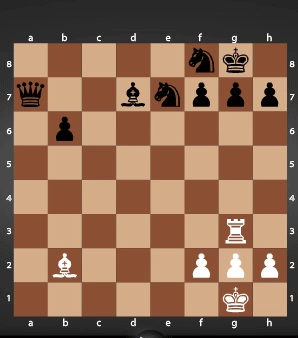
A way to protect you pieces is basically to prepare to attack your own piece. This sounds bizarre, but if you do it, you are properly protecting your pieces. This is a good example of protecting your pieces:

In the first move, black is ready to attack the first white pawn if the black pawn itself is attacked. If the white pawn captures the black pawn, the move Qxd5 would easily eliminate the white pawn. Like this, there are many other cases in the example above.
Also, this is used to prevent the opponent from checkmating your king.
Protecting your King
There are many techniques to protect your king from the threats of the opponent’s pieces during the middle of the game. These include castling, and more.
Castling is a classical example of bringing the rook into action, but at the same time, bringing your king to safety. Castling should be the first move of both the king and the rook. It is done after both the knight and the bishop between the king and the rook are cleared. It is done like:

In this example, all that really matters is the the first row. You move the king to C1, and rook to D1 at the same time in this example.
Another fairly simple way of protecting your king is to eliminate any piece that comes to your side of the board. You can do this using the threatening and protecting strategies above. Not only does this help prevent the opponent from making pawn promotions (see Game Changers), but also helps you save your king.
Special Moves
Moves that take place in special times that vary from the normal chess rules.
The Pawn Promotion » If a pawn reaches the opposite side of the board, it can transform into any other piece that has been captured. Usually, people promote the pawn to a queen as it is the most powerful piece. If so, the pawn is swapped for an inverted rook to enact as the second queen.
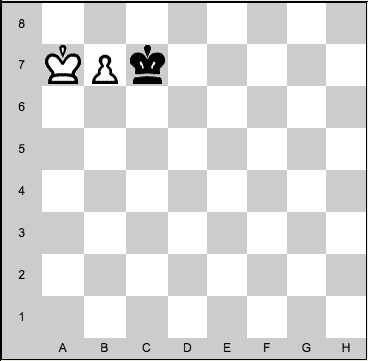
En Passent Capture »
The en passent capture or “in passing” in French, is a special pawn capture. This capture works when a pawn of the opponent is right next to your pawn, you move your pawn diagonally on square as if to capture an invisible piece. When this is done, you take the opponents pawn.

Castling »
Castling is a classical example of bringing the rook into action, but at the same time, bringing your king to safety. Castling should be the first move of both the king and the rook. It is done after both the knight and the bishop between the king and the rook are cleared. It is done like:

Forking »
Forking is a general technique that brings down you opponents material. Basically, it is preparing to attack two different pieces at a time. Here is an example of a fork:
So, in this fork, the black king is under check, so he has to move. If the king moves, the white knight is free to capture the white queen. Forks can sometimes be game changers, and players try to avoid being forked as much as possible.
Pins »
Pins are also a general chess technique. The main idea of a pin is to “pin” a piece to the king or any other valuable pieces to prevent it from moving. Here’s an example:

In this pin, if the white bishop moves as shown, it pins the queen to the king, and since the queen isn’t close to the king, the white bishop can promptly capture. Like forks, pins win.
Skewers »
Skewers are very similar to pins, but instead of the weaker piece stuck to protect the stronger piece, the strong piece is forced to move in order not to get captured, leaving the weaker piece unprotected. Here’s an example:
In this skewer, the black king is under check. He is forced to move leaving the queen unprotected, and soon captured.
Tips for the Middle Game
- Eliminate your opponents Powers, or powerful pieces to prevent your pieces from being captured.
- Bring as many pieces to the opponent’s side of the board.
- Use general Chess strategies as much as possible.
◊ – ◊ – ◊ – ◊ – ◊ – ◊ – ◊ – ◊ – ◊ – ◊ – ◊ – ◊ – ◊ – ◊ – ◊ – ◊ – ◊ – ◊ – ◊ – ◊ – ◊ – ◊ – ◊
Ending the game
You can end a game of chess with three possibilities: 1 – Checkmate, 2 – Stalemate, and 3 – Resignation.
Checkmating is when you check the opponent’s king, but wherever he goes, he is in danger. This is rarely done with only one piece, and is more commonly done after a pawn promotion. There are many different checkmates, but here are a few of the most common checkmates:
Checkmate with two rooks –
This is one of the most common checkmates people use. This checkmate happens when your opponent has no rooks, but you have both. If the opponent is not on his original rank, you can move your rooks towards the opponent king, with one of the rooks in the kings rank, and one of the rooks, on top of it. Similar mates are classified as Back Rank Mates. It works something like this:

Checkmate with the queen and knight –
This checkmate, more rarely used, is used with the queen, and knight. You can see in the picture that if the black king captures the queen (that is obviously threatening to checkmate the king), the knight can check the king making a fair and simple checkmate.
Checkmate with queen alone (two mates) –
In this mate, the queen alone makes a mate because he is blocked by his other pieces that cannot capture the queen. Even he himself cannot capture the queen. These checkmates can be quite embarrassing for your opponent!
The Fools Mate –
Chess’s fastest checkmate, the Fools Mate results in the short games of only two moves:

A stalemate is basically a draw in chess. This happens in a lot of different ways, but here are some of the most common stalemates:
Stalemate with king and pawn – In this stalemate, the black king not in a check, but if he moves anywhere else, he will fall into a checkmate. This stalemate is quite simple but will take a very long time as the king can only move one step at a time. This is shown here:

Stalemate with king and queen – This stalemate is quite simple, but like the previous one, it will take a long time for your king to reach to your opponents side of the board. Still, this is also a fairly simple one: If the king moves to F7, he will fall into check. If he moves into any other square, he will fall into check. This is shown here:
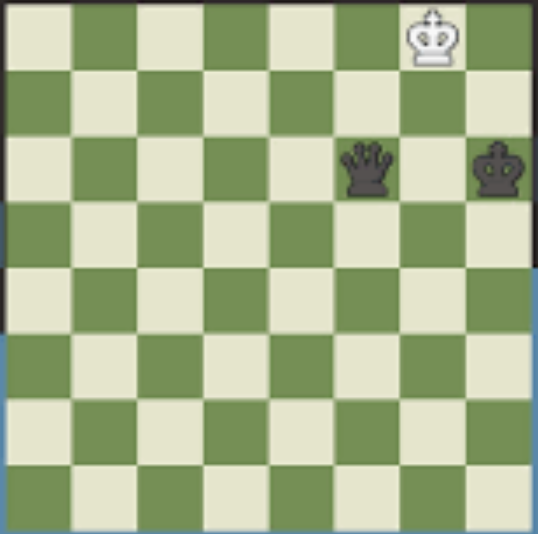
Resignations in chess happen when either you or your opponent lose a crucial piece (such as the queen or rook), when you know that you cannot checkmate your opponents king, or after the 18-move-rule has passed. In any of these ways, the person who has resigned could have resigned rationally, or maybe emotions took a toll at the player. Also, resignations may make the game a lot shorter.
Losing an Important Piece The loss of an important chess piece that could change the entire game for you could result in a resignation. for example, if you have lost all your powerful pieces and were left with only a few pawns, you would be pulled to resign from the game. Here is one situation:

In this situation, the king has nothing left. The only spark of hope for the white king is the passing of the 18-move-rule (see below). Still, black can still possibly checkmate the king using a pawn promotion.
The 18-Move-Rule
In the end of the game, if a king has no pieces left, but remains alive, a new rule called the 18-move-rule is initiated. This rule is only applied in classical classical chess. In this rule, if that king can evade capture for as long as 18 moves, it is considered that that king has won. To prevent this, your opponent will always leave one of your pieces. So, if the last piece has been captured, you still have a streak of hope.
Tips To Use in the endGame
- Try to capture any piece that comes near the back rank.
- Make sure your king does not start wandering around the board, as this could lead to an easier checkmate for your opponent.
- Try to protect your last pieces.

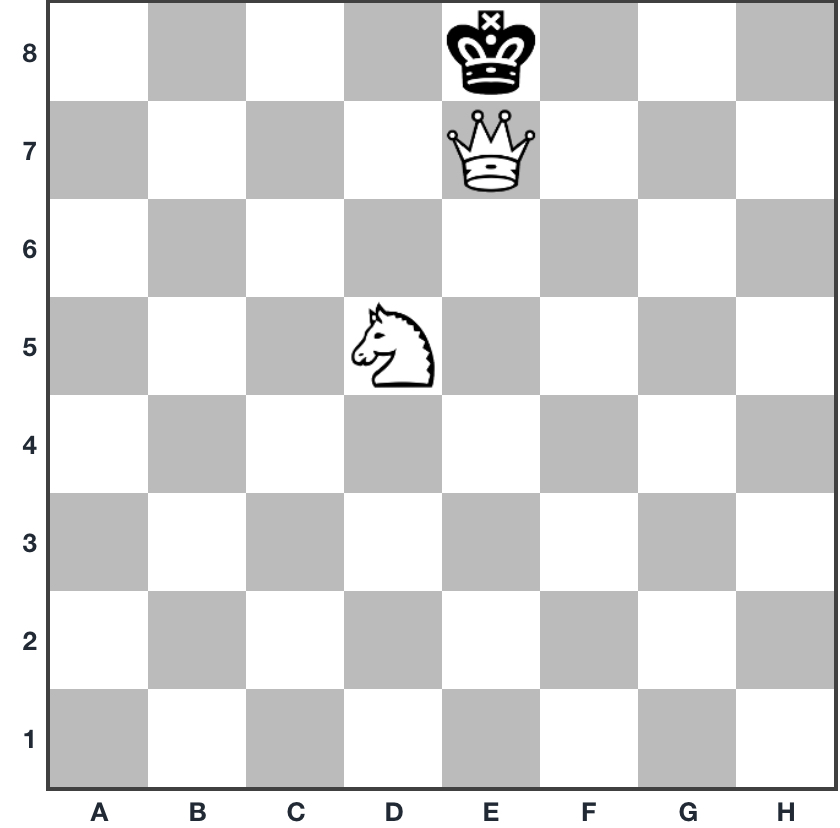

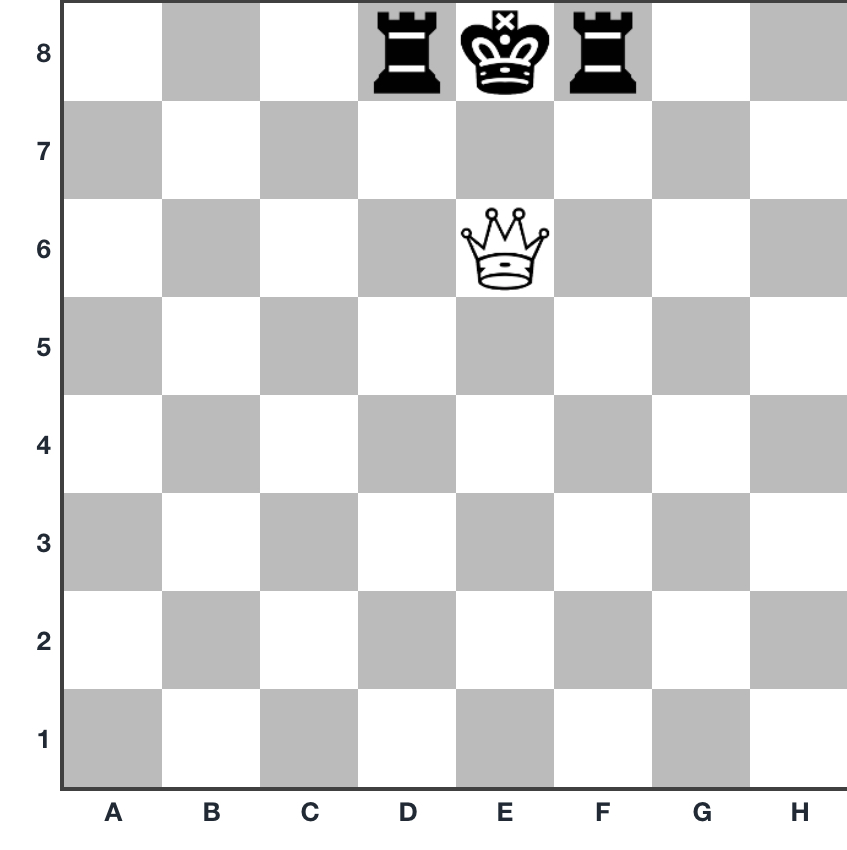
Good
LikeLiked by 1 person
Thanks! Are the techniques in the blog good?
LikeLike
thanks
LikeLike